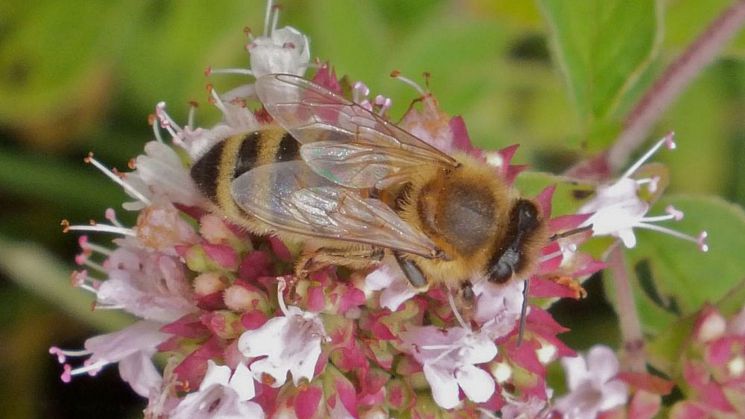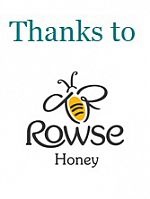Laboratory of Apiculture and Social Insects (LASI)
Bees are a vital part of our biodiversity and are the most important plant pollinator, with approximately one third of the human diet coming from bee-pollinated plants. However, bees are under threat with declines in honey bees, bumble bees and other wild bees in many parts of the world.

Honey bee collecting pollen from a Marjoram plant
In 2008, the Laboratory of Apiculture and Social Insects (LASI) at the University of Sussex started the “Sussex Plan for Honey Bee Health and well-being” to investigate practical questions that will help to address the challenges currently facing honey bees, such as parasites, diseases and lack of forage. By working on these key issues and engaging with beekeepers, farmers, schools and the wider public, we aim to help safeguard biodiversity, beekeeping and pollination in Britain for future generations.
For over a decade, we have been very grateful for the continued funding of Rowse Honey through their Hives for Lives programme. This support has been crucial in enabling LASI to focus its efforts on critical questions that will have the biggest impact on honey bees. We have also received vital funding for PhDs and outreach from a variety of supporters, including many alumni and organisations such as the Elizabeth Creak Charitable Trust, the CB Dennis British Beekeepers Research Trust, Gatwick Airport, the Esmee Fairbairn Foundation, the Phillip King Charitable Trust and the Eva Crane Trust.
The honey bee, Apis mellifera, is vital in agriculture. Honey is an important food source in its own right and each year honey bees produce c.1.6 billion kg worldwide. However, the most important role of the honey bee in agriculture is pollination. Approximately 35% of crop production worldwide is from crops that benefit from insect pollination, giving c.$250 billion added value at 2018 prices. The honey bee is the main crop pollinating bee, equal in added value to all 20,000 other bee species combined.
Honey bees and beekeeping face numerous challenges, of which two of the most important are pests and diseases, and the lack of forage and bee food supply—nectar and pollen from flowers.
Pests and Diseases
LASI’s research has shown that hygienic behaviour, a natural form of disease resistance carried out by honey bee workers, reduces the annual build-up of varroa mites (a honey bee pest) by over 60% and reduces levels of deformed wing virus 10,000-fold. LASI research has also determined the best application method and dose for controlling varroa mites with the natural chemical oxalic acid. Results show that one method, sublimation, is superior in all respects. Sublimation kills varroa at lower doses of oxalic acid than other methods, with 1-4g per hive being effective, has no adverse effects on the bees or colony, and uses less beekeeper time.
Foraging and Food Supply
To understand bee foraging, LASI’s research has taken advantage of the waggle dance, a unique honey bee behaviour. Successful foragers make waggle dances to tell hive mates where they have been foraging. By decoding videoed waggle dances made in glass-walled observation hives, LASI eavesdrops on bee foraging communication. Results show that bees fly further in summer, 2-3km on average, than spring or autumn. This indicates that nectar is harder to gather in summer and shows the importance of improving summer floral resources. LASI’s research has also used dance decoding to investigate foraging in crops, with a particular focus on apple and oil seed rape, and to determine foraging “hot spots” in the countryside.
Further research conducted at LASI has also shown that ornamental summer flowers vary 100-fold in their attractiveness to bees and other insects. This shows that parks and gardens can be made more bee-friendly at no cost by selecting more attractive varieties.
There are many good flower species for bees that can be grown in gardens, but there is no best species. But the one I can highly recommend is Marjoram. It blooms in summer when the bee food supply is most stretched, it attracts a wide range of insects, including honey bees, bumble bees, other wild bees, hover flies, and butterflies. It is also easy to grow, blooms for several months, and is beautiful.”professor Francis ratnieks
director of lasi

You might also be interested in: